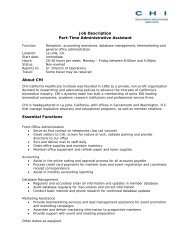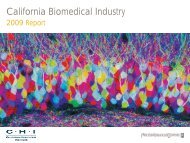California Biomedical Industry - California Healthcare Institute
California Biomedical Industry - California Healthcare Institute
California Biomedical Industry - California Healthcare Institute
You also want an ePaper? Increase the reach of your titles
YUMPU automatically turns print PDFs into web optimized ePapers that Google loves.
Using bioinformatics to detectenvironmental factors thatcontribute to diabetes<strong>Institute</strong>s: National <strong>Institute</strong> ofGeneral Medical SciencesThose who have diabetes know thatthe adult-onset form of the disease canbe triggered by, among other things,obesity and a diet high in fat. You arealso more likely to develop diabetesif other family members have it. Buta study by Stanford found that youshould also begin looking suspiciouslyat other aspects of your life — like yourpast exposure to certain pesticides orchemicals and even one form of vitaminE. In fact, the association of some ofthese so-called “environmental” cueswith diabetes surpasses that of thebest genetic markers scientists haveidentified for the disease.Breast cancer marker<strong>Institute</strong>: National <strong>Institute</strong>s of HealthWomen with breast cancer whosetumors express high levels of aparticular genetic marker aresignificantly more likely to die fromtheir disease than are those with morenormal levels, according to Stanfordresearchers. The finding implies thatblocking the action of the marker — anewly recognized type of RNA — couldone day be an effective way to preventmetastasis and improve survival forthese women, who make up about onethirdof all breast cancer patients.Antibodies and nerve repair<strong>Institute</strong>: National <strong>Institute</strong>s of HealthAntibodies — warrior proteins theimmune system makes to defend thebody against invading pathogens suchas viruses and bacteria — have a gentlerside nobody knew about until now: Theyfunction not only as soldiers but alsoas nurses. And Stanford researchersnow think antibodies’ absence in thecentral nervous system (the brain andspinal cord) may be a key part of thereason why nerve damage there doesnot get naturally repaired in humans.That insight could someday lead to newtreatments for stroke and spinal-cordtrauma.Tissue regeneration<strong>Institute</strong>: National <strong>Institute</strong>s of HealthStanford scientists have taken a big steptoward being able to confer the capacityto regenerate tissue on mammalianmuscle cells; they accomplished this featin experiments with laboratory mice inwhich they blocked the expression ofjust two tumor-suppressing proteins.The finding may move us closerto future regenerative therapies inhumans — surprisingly, by sending usshimmying back down the evolutionarytree.Lymphoma treatment<strong>Institute</strong>: National <strong>Institute</strong>s of HealthMore than half of laboratory mice withhuman non-Hodgkin’s lymphoma arecured by a treatment involving justtwo monoclonal antibodies, Stanfordresearchers have found. The therapycombines the activity of rituximab, anantibody currently in use to treat thedisorder, with another that blocks amolecule called CD47 on the surfaceof the cancer cells. Together the twoantibodies synergize to trigger the host’sown immune system to eliminate thecancer.<strong>California</strong> <strong>Biomedical</strong> <strong>Industry</strong> 2011 Report | 77






